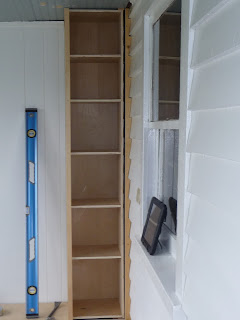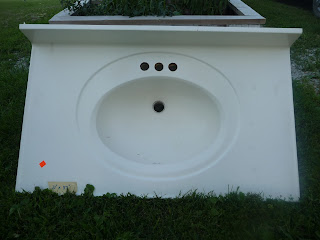Apple butter must have been "invented", when the pioneers were making applesauce and forgot about it on the fire for a long time. Applesauce cooks low and slow and eventually is cooked down into a silky, butter-like consistency. Add in some sugar and spices, and it is a delicious condiment. I found lots of recipes online, but mostly adapted mine from http://www.pickyourown.org/applebutter.htm.
Ingredients:
Makes about 8 pint-sized jars of apple butter
Applesauce, divided (either jarred or homemade from about 20 lbs of apples)
2 cups brown sugar, divided (I used brown; the recipe above uses white; other recipes don't use any and some recipes use up to 4 cups of sugar)
2 T cinnamon
1 t cloves
1/2 t allspice
Step 1- Make the applesauce. I did homemade again and it took about 20 lbs of apples- 2 full large pots of cut-up apples.
Step 2- Put the applesauce into a large crockpot until it is 1" from full. Since I made my applesauce, I didn't have time to do the crockpot in one day so I put the applesauce in the fridge overnight and started my crockpot at 8 pm the next day. I had about 6 cups of applesauce leftover so this went back in the fridge for later.
Step 3- Add 1 cup brown sugar and spices to applesauce and stir. Cover, leaving a gap to let out steam. Based on the advice from the website above, I used bamboo skewers to prop my lid up a bit.
Turn the crockpot on low and let cook until it is reduced by about half. This took about 12 hours in my crockpot. I did stir it a few times but didn't have any issues with it burning on the sides. Remember all crockpots cook differently... mine seems to cook pretty evenly and heats up pretty slowly.
Step 4- Add in the rest of the applesauce and 1 cup brown sugar and combine. I had about 6 cups left and it filled the crockpot back to 3/4 full. Continue to cook on low, partially covered for 2-3 more hours.
This is a good time to get your jars ready. Wash them in hot, soapy water and then sanitize in the dishwasher on the "sanitize" cycle or on the stove in boiling water for 10 minutes. Put the lids in a bath of almost boiling water for 5 minutes (do this right before you are ready to can).
Step 5- I wanted my butter really smooth, so I used a hand-held blender to smooth it out.
 |
Step 6- Carefully poor the molten (lava-like), hot apple butter into the hot jars 1/4" from the top. Put on the lid and lightly tighten the ring.
Step 7- Process the jars by putting them in boiling water (1" over tops of jars) for 10 minutes (check this based on your altitude!). Take them out carefully and put the processed jars in a draft-free place overnight. After they have cooled, check to make sure the button is depressed.
Processed correctly, these should last 2-3 years jarred or 2-3 weeks in the fridge. So far, we have had this on toast and on graham crackers (F's favorite). I am excited to try some melted over roasted pecans and sprinkled with salt. Sounds like the perfect fall treat to me!






















































